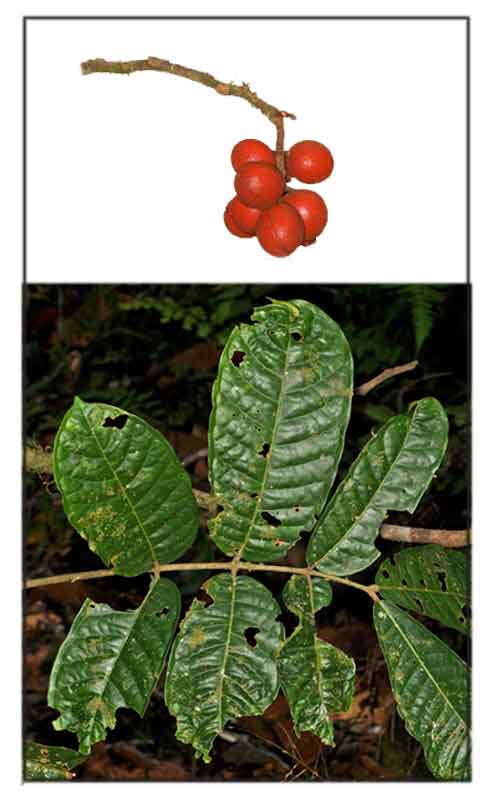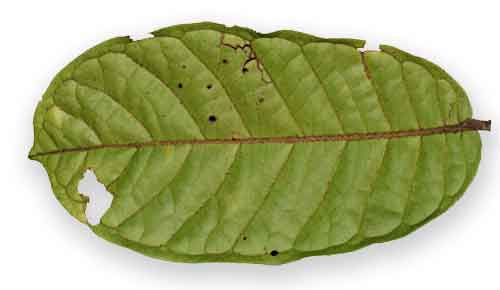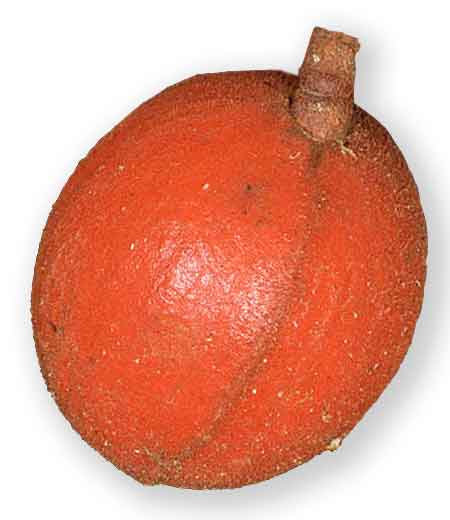Gen info
- As of April 2024, the genus Aglaia currently consists of about 121 species.
- Within Malesia, the largest number is found in Borneo (50), followed by Peninsular Malaysia (48), Sumatra (38), Philippines (35), and New Guinea (33). (2)
- Etymology: The genus name derives from Greek mythology Aglaia, one of the three Graces (minor goddesses of grace, charm, and beauty who were daughters of Zeus) in reference to the sweetly-scented flowers of the tree.
 Botany Botany
• Tree up to 20(-27) m. Bole up to 35 cm diameter, with small buttresses. Branches ascending or patent. Bark smooth, pinkish-brown, grayish green or very pale gray, with orange longitudinal and round lenticels and green longitudinal streaks and transverse ridges, inner bark green or yellowish-brown; sapwood pale orange brown or pale yellow; very little white latex. Twigs slender, densely covered with or with numerous pale yellowish-brown stellate hairs or scales. Leaves imparipinnate. up to 40 cm long and 30 cm wide; petiole up to 9 cm, petiole, rachis and petiolules with indumentum like the twigs. Leaflets 3-11,4.5-22 by 2-9 cm, subcoriaceous, both surfaces rather shiny when dry, acuminate-caudate at apex, cuneate or rounded at the asymmetrical base, with few to densely covered with pale brown stellate hairs on the midrib below and occasional on the rest of that surface; veins 5-10 on each side of the midrib, reticulation visible or subprominent on upper surface and subprominent on lower surface; petiolules up to 12(-20) mm. Inflorescence 10-20 cm long and 9-15 cm wide; peduncle up to 4 cm, peduncle, rachis and branches with surface and with numerous to densely covered with hairs like those on the twigs, the pedicels and calyx dark brown or black when dry and the calyx without or with very few pale brown stellate scales. Flowers up to 2 mm long and 2.5 mm wide; pedicels up to 1.5 mm. Petals 5. Staminal tube about half the length of the corolla, c. 1.3 mm across, depressed-globose with the aperture c. 0.8 mm across; anthers 5. obovoid, about half the length of the tube inserted about halfway up the tube and just protruding beyond the aperture. Infructescence with few fruits; peduncle up to 2 cm. Fruits 1-3 cm in diameter, subglobose; the pericarp brown or yellow, either thin, hard and brittle or thick, woody and longitudinally ridged, densely covered with pale yellowish-brown stellate hairs on the outside. Locule(s) 1 or 2, each containing 1 seed, with a translucent gelatinous, white or brown, sweet edible aril. [from Flora Malesiana] (6)
Distribution
- Native to the Philippines.
- Also native to Andaman Is., Borneo, Cambodia, Laos, Malaya, Myanmar, Sumatera, Thailand, Vietnam. (1)
- A sub-canopy tree, in deciduous and evergreen primary forest, secondary forest, swamp forest, riverrine forest, and in kerangas; on limestone, granite, basalt, sandy loam and clay, from sea level to 850 m elevation. (4)
- In 1998, listed as Near Threatened in the IUCN Red List of Threatened Species.
 Constituents Constituents
- Repeated column chromatography separation of chloroform extra ct of trunk yielded one triterpene, suggested to b e stigmasterol (1), while the methanol extract of trunk yielded a triterpene, ß-sitosterol (2). Petroleum ether extract of stem afforded a new triterpene, namely oligophyllic acid (3). (see study below) (3)
- Phytochemical study of stem bark afforded
afforded a dammarane acid type of compounds, namely 20S,24R-epoxy-25-hydroxy-2-methoxy-2,3-secodammarane-3-oic acid (77) and 20S,24S-epoxy-25-hydroxy-2-methoxy-2,3-secodammarane-3-oic acid (78) while separation work from the trunk of Aglaia oligophylla successfully isolated one compound identified as silvaglin A (47) along with beta-sitosterol (30). (7)
Properties
- Studies have suggested cytotoxicity, antioxidant, anticancer, insecticidal properties.
 Parts used Parts used
Trunk, stem, twigs.
Uses
Edibility
- Fruits are edible with an acid or sweet flavor. The translucent, gelatinous fleshy coating (aril) around the seed is eaten. (4)
Folkloric
- No reported folkloric medicinal use in the Philippines.
Others
- Wood: Sapwood is pale brown-orange or pale yellow. Wood used as timber. (4)
Studies
• Antioxidant / Trunk and Stem: Study evaluated the antioxidant capacity of trunk and stem of Aglaia oligophylla plant extracts and its phytoconstituents. Antioxidant activity was measured using cupric reducing antioxidant capacity (CUPRAC) and ferric reducing antioxidant power (FRAP) assays. In CUPRAC assay, the ethyl acetate extract of trunks exhibited the strongest reducing capacity with 1543 mg Trolox equivalent (TE)/g while the methanol extract of trunk and stem part showed strongest reducing power with 1269 mg TE/g and 1084 mg TE/g respectively. (see constituents above) (3)
• Cytotoxicity Testing / Anticancer / Antioxidant / Trunk and Stem: Study evaluated stem bark and trunk of Aglaia oligophylla for antioxidant and cytotoxicity activity. Among various extracts, the ethyl acetate extract of trunk exhibited strongest antioxidant activity in ABTS and CUPRAC assays with values of 96.97 and 1696.48 m g TE/G respectively, while the methanol extract of trunk showed strongest antioxidant activity in FRAP assay with value of 1312.03 mg TE/g. The chloroform trunk extract showed strongest cytotoxicity against MCF-7 cell line with IC50 of 35.45 µg/mL while oligolin A displayed strongest cytotoxic effect against MDA-MB-231 cell line with IC50 of 14.23 µg/mL. Oligolin A treated MDA-MB-231 cells showed morphological changes such as cell shrinkage, nuclear compaction and membrane blebbing which further supported cytotoxicity. (5)
• Insecticidal Roglamide DerivativesTesting / Twigs: Study of organic-soluble extracts of twigs of Aglaia oligophylla isolated four insecticidal cyclopentatetrahydrobenzofurans of the rocaglamide type including a new natural product (compound 4), along with two cyclopentatetrhydrobenzopyran derivatives, belonging to the aglain and aglaforbesin types, respectively. All isolated rocaglamide derivatives exhibited strong insecticidal activity toward neonate larvae of the polyphagous pest insect Spodoptera littoralis when incorporated into an artifical diet, with LC50s between 2.15 and 6.52 ppm. (8)
Availability
Wildcrafted. |

![]()






